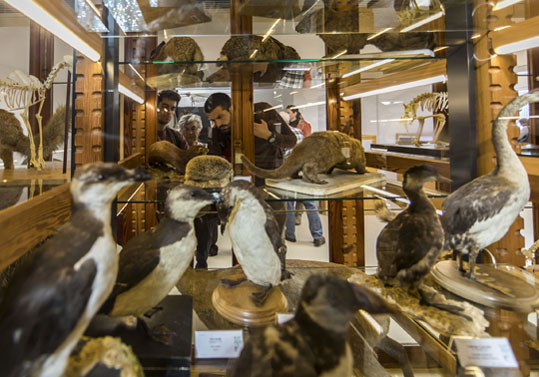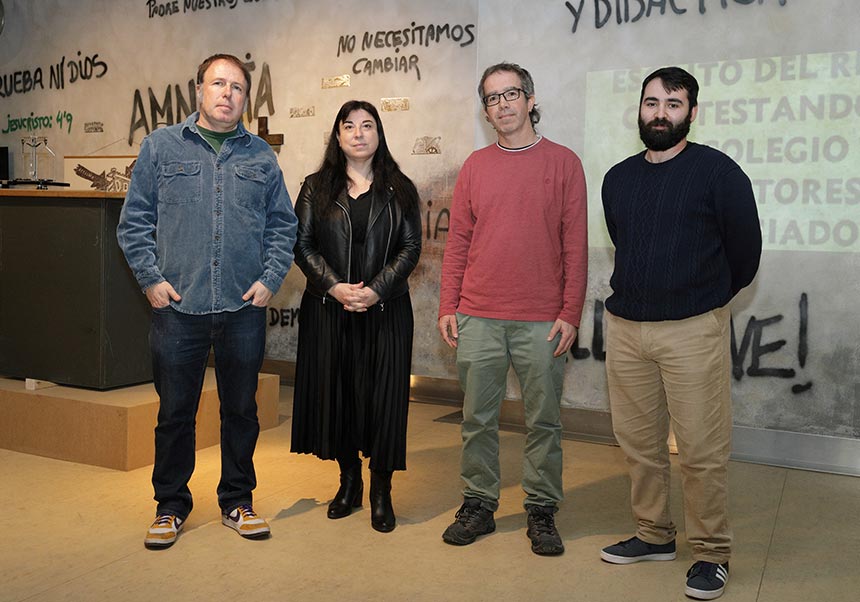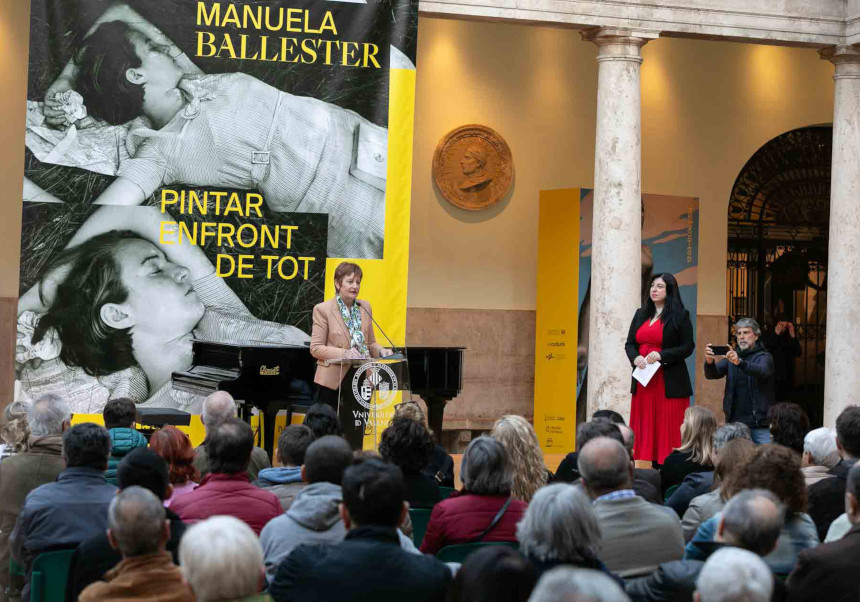The Universitat de València inaugurates the Natutal History Museum
- Office of the Vice-Principal for Culture and Society
- February 16th, 2018

The Museum of the Universitat de València: Natual History M[UV]HN (#MUVHistoriaNatural) is a new facility of the Universitat de València. It aims to collect in a single building the most important pieces of its 32 scientific collections, which include thousands of samples. This way, it can offer this enormous scientific and cultural patrimony to the Valencian society. In addition, M[UV]HN becomes a research and training area for the university community and the general public. The new museum is located in the central square on the Burjassot Campus (50 Doctor Moliner St.).
The Principal of the University Esteban Morcillo inaugurated last Thursday this building. The Autonomous Secretary for Culture, Albert Girona, and the President of the Council of Valencia, Jorge Rodríguez.; were present. The Dean of the Faculty of Biological Sciences was also present at the event. Both Esteban Morcillo and Javier Lluch have indicated that “it is not a birth, but a rebirth of the old Natural History office, which was considered the second best collection in Spain in 1932”. Esteban Morcillo referred to the museum as “a treasure that has been obtained thanks to the cooperation of the Office of the Vice-principal for Culture, Research and infrastructure of the University. In addition, Lluch has reminded that this museum “exhibits a small part of the legacy owned by the University”. Only 5% of the zoology collection of the University is exhibited.
Albert highlighted the importance of the fact that this museum is integrated in the Xarxa de Museus de la Generalitat. According to Girona, “there are museums lacking important exhibitions. But this one is not one of those”. The University has been able to create a museum that has a backstory for Valencians.”
The Provincial Council of Valencia was involved in the implementation of the Natural History Museum of the University by providing 100,000 €. This strengthens the cooperation between both institutions in territorial integration and the transfer of knowledge. In words of the President, Jorge Rodríguez: “This new area of scientific dissemination shows the potential and necessity of the cooperation among public administrations. It has permitted to recover important assets of the old Natural History Museum and show them to the Valencian society”.
Rodríguez valued these 32 collections offered to the visitors in the new museum located in Burjassot. He celebrated that this town located in the Horta Nord was the new head office of the Natural History Museum. “For the Provincial Council, it is important that scientific, educative and cultural offer is accessible throughout Valencian regions. It is important that they have access to the events organized by the university.
The director of the Natural History Museum, Anna García, stated that several institutes of the province have already asked for guided visits as well as an itinerant sample with pieces of the museum travelling to different towns. A lot of these pieces have been collected in Valencian territory during the last decades.
The General Director of Culture and Patrimony, Carmen Amoraga; the Regional Director for Presidency of the Valencian Government, Francisco Molina; the President of the Spanish Palaeontology Society, Maria José Comas; the director of Museo Príncipe Felipe, Miriam Atienza; the director of the Natural History Museum, Margarita Belinchón; the Mayor of Burjassot, Rafael García; and university representatives attended the inauguration.
The museum counts with the sponsorship of the Valencian Government, the Provincial Council of Valencia, the Department of Education, Research, Culture and Sports (General Direction for Culture and Heritage and the Secretary for Education and Research) and the cooperation of the General Foundation of the Universitat de València. It is located in one of the rooms of the General Services Building on Burjassot Campus, which has been set up for this purpose. Anna García Forner will be the provisional director of the museum until a technical direction is formed.
Most of the collection comes from the Museum of Geology of the University. Some of the samples come from the Natural History Museum of the Universitat de València. It contained most of the scientific patrimony of the University from the second half of the 19th century until a devastating fire destroyed it in 1932. Most of the collections were burned, too. As it is a university museum, exhibited samples are just a small part of the collection owned by the institution.
The Natural History Museum of the Universitat de València was the second patrimonial and scientific centre in Spain (only behind the National Natural Sciences Museum in Madrid). It was located in the main floor of the southern wing of the historical building of the University, currently the Cultural Centre La Nau. Only a few zoological and botanical specimens that the University had been collecting for 5 years were rescued from the fire, but the geological and palaeontological samples were lost. Zoological taxidermy samples are exhibited now in the zoological room of the new museum.
The museum area spans 900 m2 divided in two floors. The building is dedicated to the three basic principles of a museum: exhibit, train and research. In the ground floor, permanent and specialized exhibitions are set in three different areas.
First, there is the entrance hall, where you can find one of the most emblematic pieces, the reconstruction of the pterosaurs. On the left wing there is the zoology room, where you can find the historical collection of taxidermies (mainly birds). In the same room, you can take a look at different animal skeletons mostly assembled as teaching activities. They are useful as comparison samples. On the right wing there is a geology and palaeontology exhibition room. Inside this room, there is an area where you can visit “the meteorite”. There is also an exhibition of fossils, rich mineral and rocks collections didactically organised, and a glass cabinet with fluorescent minerals.
The laboratory section for preservation and research is formed by four wings. On the ground floor, there is a restoration laboratory aiming to make palaeontological materials visible for the public from the entrance. The other three laboratories are in the upper floor. The first one is responsible of making moulds and replica. The second one is a restoration laboratory in charge of biological preparation and the last one handles rocks and industrial minerals.
The museum is also present outside of the building as there is a didactic path through a botanical and geological garden. The latter one is currently being built up. So far, three different rocks present in the Valencian Community integrate it.
The Natural History Museum of the Universitat de Valencia aims to show the diverse collection that they take care of, and become a scientific and technical information documentation centre for the general public and specialists. This way, a perfect area for meetings, conferences, colloquia and debates about current scientific issues is created.
Among the most emblematic pieces of the Museum a meteorite stands out. It was officially named “València”. It weighs 33.5 kg, has a size of 37 x 24.5 x 19.5 cm and a formation age close to 4,600 million years. The Nomenclature Committee of the Meteoritic Society is the international organization in charge of recognizing and registering all known meteorites. In 1997, it accepted “València” as the name of the meteorite.
Other important piece is the reconstruction of the pterosaurs, one of the first vertebrates that conquered the air in the Mesozoic Era (from 228 to 66 millions of years ago). The University preserves fossils of this specimen in the museum. By means of augmented reality, the audience will be able to note the aspect and singular flight of this reptile.
There are also some tracks of Late Triassic turtles that a team of palaeontologists of the Universitat de València had found in three different outcrops in the province of Valencia. This discovery is one of the oldest records of this type of vertebrate in the World. It is dates back to 227 millions of years ago. It increases the knowledge on the evolution and diversification of this group of specimen and its relation with the aquatic environment.
The TV of the Universitat de València (MediaUni) has made a promotional video for this new museum. It addresses its story and includes interviews. Link to the video: http://links.uv.es/tvELD2O
More information:
File in: Cultura , Exposicions , Altres espais expositius
















